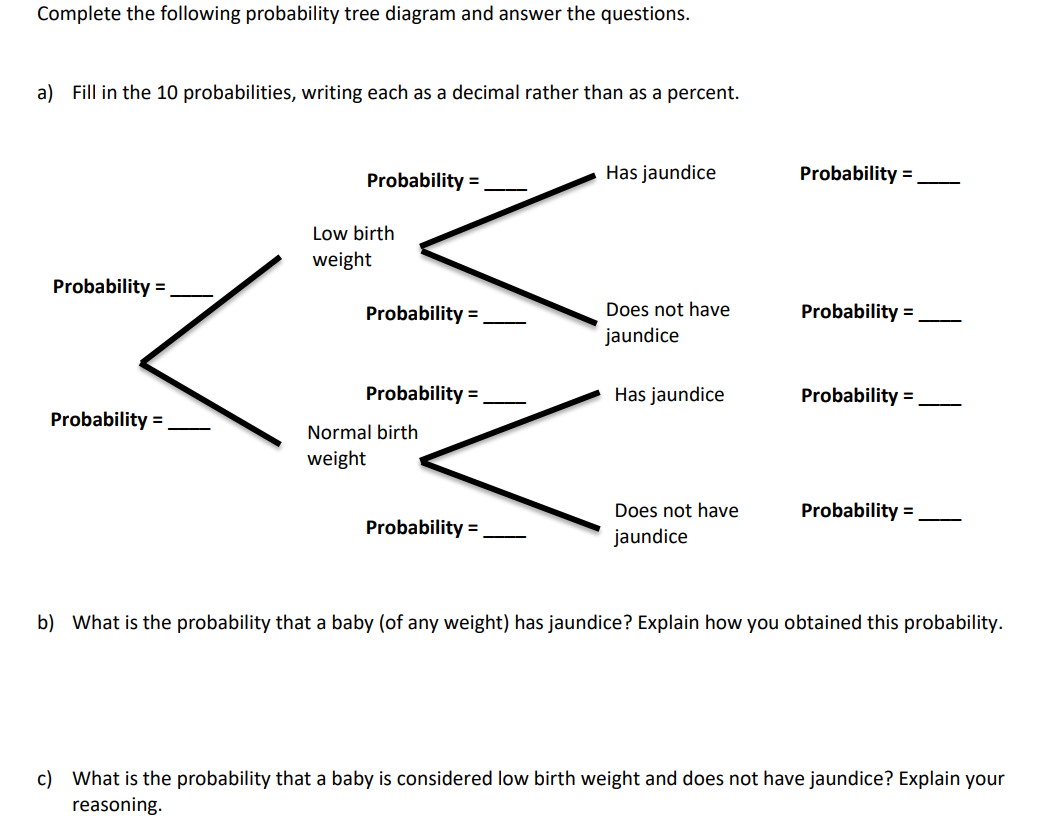Complete the following probability tree diagram and answer the questions. a) Fill in the 10 probabilities, writing each as a decimal rather than as a percent. Probability = Has jaundice Probability = Low birth weight Probability = Probability = Does not have Probability = jaundice Probability = Has jaundice Probability = Probability = Normal birth weight Does not have Probability = Probability = jaundice b) What is the probability that a baby (of any weight) has jaundice? Explain how you obtained this probability. c) What is the probability that a baby is considered low birth weight and does not have jaundice? Explain your reasoning.
Complete the following probability tree diagram and answer the questions. a) Fill in the 10 probabilities, writing each as a decimal rather than as a percent. Probability = Has jaundice Probability = Low birth weight Probability = Probability = Does not have Probability = jaundice Probability = Has jaundice Probability = Probability = Normal birth weight Does not have Probability = Probability = jaundice b) What is the probability that a baby (of any weight) has jaundice? Explain how you obtained this probability. c) What is the probability that a baby is considered low birth weight and does not have jaundice? Explain your reasoning.
Linear Algebra: A Modern Introduction
4th Edition
ISBN:9781285463247
Author:David Poole
Publisher:David Poole
Chapter2: Systems Of Linear Equations
Section2.4: Applications
Problem 28EQ
Related questions
Question
Help me please

Transcribed Image Text:Complete the following probability tree diagram and answer the questions.
a) Fill in the 10 probabilities, writing each as a decimal rather than as a percent.
Probability =
Has jaundice
Probability =
Low birth
weight
Probability =
Probability =
Does not have
Probability =
jaundice
Probability =
Has jaundice
Probability =
Probability =
Normal birth
weight
Does not have
Probability =
Probability =
jaundice
b) What is the probability that a baby (of any weight) has jaundice? Explain how you obtained this probability.
c) What is the probability that a baby is considered low birth weight and does not have jaundice? Explain your
reasoning.

Transcribed Image Text:1) A newborn baby is considered to be "low birth weight" if the baby weighs less than 5 pounds, 8 ounces at birth.
Many low-birth-weight babies are perfectly healthy even though they are small. But having a low weight at birth
can cause serious health issues for some babies. The two primary reasons a baby is born with low birth weight
are that they were born prematurely or that they experienced some growth restrictions as a fetus. In the United
States, about 8% of babies are considered as being low birth weight.
Many newborn babies – both those considered low birth weight and those that are born at a normal weight –
experience a condition called "jaundice", in which there is an excess amount of bilirubin in the blood causing the
baby's eyes and skin to take on a yellowish color. About 80% of low-birth-weight babies experience jaundice,
while about 60% of babies who are born at a normal weight experience some level of jaundice.
Expert Solution
This question has been solved!
Explore an expertly crafted, step-by-step solution for a thorough understanding of key concepts.
Step by step
Solved in 4 steps with 1 images

Recommended textbooks for you

Linear Algebra: A Modern Introduction
Algebra
ISBN:
9781285463247
Author:
David Poole
Publisher:
Cengage Learning

Algebra for College Students
Algebra
ISBN:
9781285195780
Author:
Jerome E. Kaufmann, Karen L. Schwitters
Publisher:
Cengage Learning

Trigonometry (MindTap Course List)
Trigonometry
ISBN:
9781337278461
Author:
Ron Larson
Publisher:
Cengage Learning

Linear Algebra: A Modern Introduction
Algebra
ISBN:
9781285463247
Author:
David Poole
Publisher:
Cengage Learning

Algebra for College Students
Algebra
ISBN:
9781285195780
Author:
Jerome E. Kaufmann, Karen L. Schwitters
Publisher:
Cengage Learning

Trigonometry (MindTap Course List)
Trigonometry
ISBN:
9781337278461
Author:
Ron Larson
Publisher:
Cengage Learning